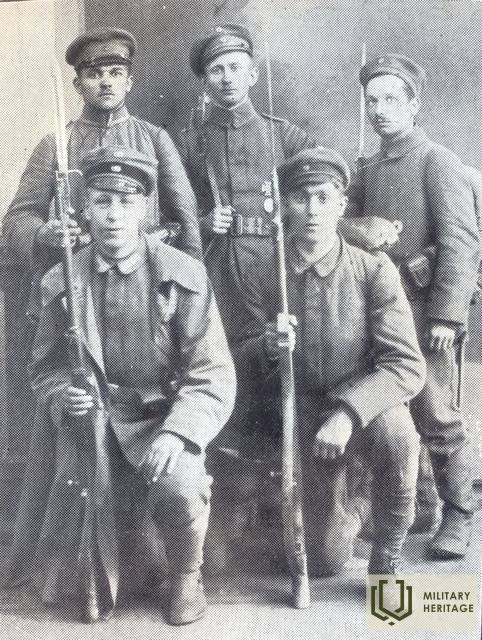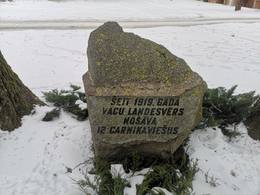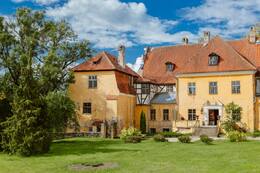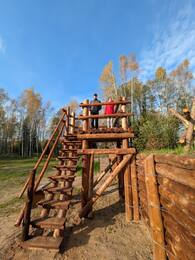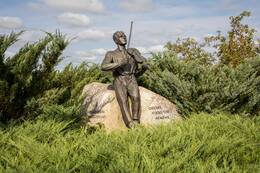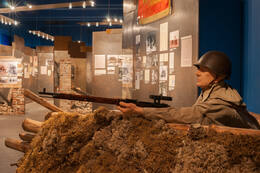Landeswehr. Baltic Landeswehr
I Wars of Independence
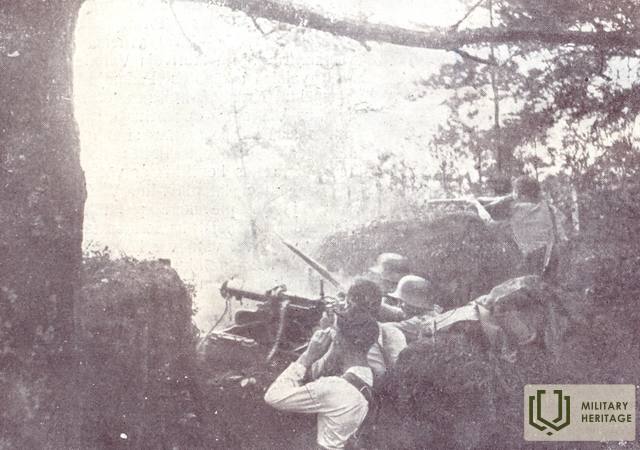
Landeswehr. Baltic Landeswehr (German: Baltische Landeswehr, Russian: Балтийский ландесвер, English: Baltic Land Defence, Baltic Territorial Army, Baltic Home Guard)
The Baltic Landeswehr was a self-defense structure of the inhabitants of the German-occupied Baltic provinces, the preparatory work for which began in the early autumn of 1918, but in the second half of November it was incorporated into the armed forces of the newly founded Republic of Latvia - the Latvian Land Guard (German: die Lettländische Landeswehr), colloquially called the "Landeswehr" or "Baltic Landeswehr".
The multi-ethnic (Baltic Germans, Latvians, Russians) "Latvian National Guard", with German military support, became the armed forces of Latvia. Administratively, it was subordinated to the Minister of Defense of Latvia, Jānis Zālītis, but in terms of logistics and military - to the leadership of the German occupation forces. The agreement between the Latvian government and the German representative August Vinnig provided for the formation of the National Guard on a voluntary basis from 18 Latvian, 7 German and one Russian company, the commander of the National Guard was to be a representative of a neutral country (Sweden) according to the original plan, but this did not materialize. Already at the end of November, Vinnig had formed the Iron Brigade (later the Iron Division) from the soldiers of the departing German troops, whose soldiers had the opportunity to receive Latvian citizenship and land according to the December agreement.
The Germans and Baltic Germans continued to call the troops the Baltic Landeswehr, not the Latvian Landeswehr. The Latvian companies that began to form within the Landeswehr took their names from the name of the place of formation (Riga, Cēsis, Jelgava, Latgale) or composition (Officer, Student). Lieutenant Colonel Oskars Kalpaks was appointed commander of the Latvian units.
In early February, General Rüdiger von der Goltz arrived in Liepāja. He was appointed commander of the German armed forces (which included the Baltic Landeswehr and the Iron Division) in Courland and Northern Lithuania, as well as governor of Liepāja. On April 16, 1919, units of troops subordinate to Goltz in Liepāja carried out a coup against the Latvian Provisional Government.
The Baltic Germans, who had united in the Baltic Landeswehr, at various stages of the War of Independence both supported the Provisional Government established by the Latvian People's Council with Kārlis Ulmanis at its head, and fought against it when they sided with the illegal government of Andrievs Niedra. If initially both German and Latvian units had a common goal – to liberate Latvia from the Bolsheviks, then after the liberation of Riga in May 1919, the hostilities of the Landeswehr and the German Iron Division were directed not against the Bolsheviks, but against the troops of Northern Latvia loyal to the legal Latvian Provisional Government and the Estonian army. After the battles of Cēsis, in which the Landeswehr and the Iron Division were defeated, the Landeswehr units loyal to the Latvian state continued the fight against the Bolsheviks. On March 30, 1920, the Landeswehr was transformed into the 13th Tukums Infantry Regiment and included in the Kurzeme Division. On April 1, 1922, the regiment was disbanded, and the soldiers were added to the 7th Sigulda Infantry Regiment.
The best-known Landeswehr commanders were Alfred Fletcher (1 February 1919–12 July 1919) and Harold Alexander (12 July 1919–18 February 1920).
More information sources
Ēriks Jēkabsons. Latvian War of Independence. The struggle of the Latvian Provisional Government and its armed forces to ensure the independence of Latvia from 18.11.1918 to 11.08.1920. – National Encyclopedia: https://enciklopedija.lv/skirklis/22216-Latvijas-Neatkar%C4%ABbas-kar%C5%A1
The Fight for Freedom: The Latvian War of Independence (1918–1920) in the Documents of the Latvian State Historical Archive, Part 1, November 18, 1918–April 16, 1919, comp. Ē. Jēkabsons and J. Šiliņš, Riga, Latvian National Archives, 2019.
“Fight for Freedom: The Latvian War of Independence (1918–1920) in the Documents of the Latvian State Historical Archive” Part 2. April 16–July 10, 1919, comp. Ē. Jēkabsons and J. Šiliņš, Riga, Latvian National Archives, 2019.
Latvian freedom struggle (see literature and external links). Wikipedia page: https://lv.wikipedia.org/wiki/Latvijas_br%C4%ABv%C4%ABbas_c%C4%AB%C5%86as
Related timeline
Related objects
The monument commemorates the Carnikavans shot in 1919 by Landeswehr
Located in the SW corner of Carnikava Park at the intersection of Jūras Street and Nākotnes Street between two oak trees.
A granite monument to 12 Carnica residents who were killed by German Landeswehr units in the spring of 1919 for allegedly visiting the "red group".
Lielstraupe Castle
The Lielstraupe Castle is located in the centre of the town of Straupe. The castle is open to visitors and offers a journey through the centuries along with an orienteering exercise in the labyrinths of the castle. During the Battles of Cēsis, the Lielstraupe Castle housed the command post of Paul Ludwig Ewald von Kleist’s Battle Group of the Iron Division (German: Eiserne Division). During the battles, the castle was visited by Major Josef Bischoff, Captain Heinz Guderian and others. The castle was used for the coordination of an attack in the direction of Stalbe on 21-22 June. The Iron Division was a military force of German mercenaries during the Latvian War of Independence, which was formed from soldiers of the 8th Army of the demobilised German Empire and volunteer mercenaries. It was the best-known part of the German Free Corps and among the best trained and most combat-ready military forces in the Baltics in 1919. During the Soviet period, from 1949 to 1959, the administration of the Lielstraupe Machine-tractor Station operated out of Manor Castle. During this time, the castle was also equipped with training rooms and dormitories for tractor drivers, while the former stable of the manor housed workshops. From 1963 to 2018, the castle was managed by medical institutions, and it was said of the Straupe Narcological Hospital in Latvia that it ‘even treats the walls’.
Christmas Battle Museum
The museum is located in “Mangali” house, Valgunde Rural Territory, Jelgava Municipality, and it is a branch of the Latvian War Museum. It was unveiled in 2005 at the site of the Christmas Battles that occurred during World War I. Unique World War I fortifications still remain at the battle sites. The open-air exhibition of the Christmas Battle Museum reconstructs a section of the fortification system – the trench shelter and part of the first line of German defence – the “German rampart”, which is the only object of this kind in the Baltic states.
The Christmas Battles are one of the best known and most dramatic events of World War I in Latvia. They are an event of special importance in Latvian military and cultural history. Intense fighting took place for six days, leading to heavy casualties. The battles are mainly associated with the attack of Latvian Riflemen against the German Army units, which took place in particularly severe and unfavourable winter conditions. This is an unprecedented case of a major combat operation launched without artillery support.
Today, the museum artefacts found at the sites of the battle are on display. The indoor exhibition is open at certain times, while the exhibition of outdoor fortifications is open every day. Tourist routes and nature trails have been created in the surrounding area.
Monument to the first battle for Latvia's independence
Located in Inčukalns, Atmodas Street 2.
On July 3, 2016, a monument to the first battle for Latvian independence was unveiled, dedicated to the Latvian Landeswehr (Die Lettländische Landeswehr), in which local Baltic Germans, Russians and Latvians, who were in units on both sides at the time, defended the newly founded state against the Bolshevik Red Army. Eižens Upmanis, the chairman of the Brothers' Graves Committee, concluded at the time that this could be the first monument to the combined Latvian and Baltic German forces in battle memorials outside the cemeteries. At that time, Lieutenant Colonel Oskars Kalpaks was appointed commander of the Latvian units of the Latvian Landeswehr, from whose units the later Latvian Army grew and formed during the Freedom Struggle.
In 1918, the entire territory of present-day Latvia had fallen into the hands of the German Empire and its troops. However, in the late summer and autumn of 1918, the situation began to rapidly turn against Germany and it was clear that it was only a matter of time before Germany would be forced to admit defeat in World War I. The Russian Empire, which Latvia was part of until World War I, had ceased to exist earlier, with the February and October revolutions of 1917. On 18 November 1918, the Republic of Latvia was proclaimed. The German army, which was located in the territory of Latvia, after the armistice with the Entente powers on 11 November 1918, was no longer motivated for further hostilities and most of its soldiers simply wanted to return to their homeland.
Under such circumstances, it was clear that the defense of Latvia depended primarily on a national guard formed by the Latvian population itself. Initially, due to their education and relatively greater ability to self-organize, the Baltic Germans living in Latvia showed the greatest initiative in forming such a national guard. Russian soldiers also joined the national guard. In order to ensure the supply of the national guard with uniforms, weapons and other necessary resources, the Latvian Provisional Government concluded an agreement with the German representative Augustus Vinnig on December 7, 1918, providing for the provision of the national guard from the German army reserves located in the territory of Latvia. This agreement indicated, among other things, that this national guard, with the official name “Latvijas zemessardze” or in German – “die Lettländische Landeswehr”, would be the armed forces of the Republic of Latvia.
The Latvian National Guard was confronted by two Latvian Red Riflemen regiments (i.e., approximately 2,000–3,000 soldiers) that had previously been experienced in World War I and the Russian Civil War. Despite the Red Army's experience and numerical superiority, the Latvian National Guard held Inčukalna in fierce battles for two days, until finally, on the evening of January 1, 1919, in order to avoid encirclement, it was forced to retreat, losing 43 killed and several wounded, most of whom were captured by the Bolsheviks, where they were killed or died of hunger or disease.
Author: Artis Buks. Material: Fieldstone. The monument is made of a large monolithic stone that was found in Ruļļi near Jelgava.
The birthplace of Colonel Oskars Kalpaks “Liepsalas” and the final resting place in Visagals cemetery
The Colonel Oskars Kalpaks family memorial in Liepsalas is located in the area between Madona and Lake Lubāns. Liepsalas is Kalpaks’ childhood home. The memorial site was established here in 1997 based on the ideas and using the resources of the colonel’s niece, Ārija Kalpaks-Grundmane (1922-2006). The site consists of various environmental objects and stone sculptures with a symbolic meaning, signifying Latvian ethical and patriotic values. The largest building houses an exhibit dedicated to the history of the Latvian War of Independence and the 22 years of Latvian freedom (1918-1940). Located in the Visagals graveyard, the monument to Oskars Kalpaks, created by Kārlis Zāle and Arnolds Dzirkals, was unveiled in 1927. The monument consists of a composition of three figures, in the centre of which is an ancient Latvian warrior holding a shield and a sword, with a falling soldier on each side. Placed obliquely on a granite base, a bronze plaque at the foot of the sculptural group contains engraved text, including a poem, dedicated to Kalpaks, by Edvards Virza. Oskars Kalpaks died on 6 March 1919 near Airītes, by the road from Skrunda to Saldus.
Railway bridge over Amata
Located in Drabeši parish, Cēsis region, near the recreation area "Meža koujas".
A railway bridge over the Amata River is visible.
The railway bridge over the Amata River plays a very important role throughout the course of the War of Independence, as the first battle between the Estonian army's armored trains and the Baltic Landeswehr units took place here on June 5, 1919. The Landeswehr, knowing that the armored train was approaching, mined the railway bridge and took up positions in the "Amata" houses on the riverbank, ready for possible hostilities. The bridge over the Amata River was the border between the Estonian forces and the Germans.
Historical evidence of the events at the Amata Bridge has not been preserved. Since Latvians did not participate in these events, there are no memoirs from them, there are memories from Estonian soldiers, other sources. It can be said that this was a joint Estonian-American battle against the Landeswehr, because an American officer was on the Estonian armored train, who later also fought in World War II. In general, many future officers and commanders of World War II participated in the Cēsis battles, especially on the German side.
The Estonian armored train arrived in Cēsis on June 2, 1919, and a day later went to Ieriķi, where negotiations with the Landeswehr took place, which were fruitless, and on June 5, when the armored train again approached the Amata Bridge, a clash with the Germans began. The armored train also took part in the battles near Cēsis a day later, where it helped the soldiers of the Schoolchildren's Company, who were threatened with encirclement. Although the Germans tried to dismantle the tracks to cut off the train's retreat, it managed to retreat across the Rauna Bridge.
On the night of June 23, 1919, during the Battle of Cēsis, the Landeswehr abandoned Cēsis and retreated to the Amata River. While retreating, the Germans burned down the Cēsis Latvian Society building and blew up the bridge over the Amata.
Monument to the first fallen soldier of the School Company, Edgars Krieviņš
Located in the Valmiera City Center Cemetery, near the chapel (Miera Street 1/3, Valmiera)
A soldier of the 8th (Student) Company of the Cēsis Regiment, LKOK Edgars Krieviņš (1899-1919), died on June 7 from injuries sustained in the Battle of Cēsis on June 6, 1919, when, when the enemy attacked, he covered the retreat of the rest of the units.
Latvian War Museum
The Latvian War Museum is located in the Old Town not far from the Freedom Monument in a historic defence building called the ‘Powder Tower’. There are 11 exhibits in the museum. There are various weapons, documents, uniforms, awards, badges and other items detailing the everyday life of a soldier in war. The Latvian War Museum is one of the oldest museums in Latvia. Its origins can be found in World War I. Museum’s collection was made up mainly of personal items of soldiers or items found on battlefields. After Latvia gained its independence the main goal of the museum became to create an exposition on the military history of Latvia and the active role of the population in protecting their land. In 1937 the museum was expanded and was technically one of the most modern museums in Europe at that time. The Powder Tower was one of the fortification towers of Riga. Some evidence dates back to 1330 where it has been mentioned as the ‘Sand Tower’. The tower was destroyed in 1621 when Riga was besieged by the Swedish Army. But in 1650 a new tower for storing gunpowder and weapons was built. After the city’s fortifications were taken down, the Powder Tower remains as one of the most important pieces of evidence of the Riga defence system.
Related stories
The beginning, course and conclusion of the Battle of Cēsis
The victory in the Battle of Cēsis was destined to become a turning point in the Latvian and Estonian struggle for the independence of their country. This victory put an end to the plans of the Andrievs Niedra government and the German general Rüdiger von der Goltz to conquer the Baltics. Instead, the Latvian Provisional Government of Kārlis Ulmanis resumed its activities in Liepāja.
About the national patriot First Lieutenant Vili Gelbi
The fate of Lieutenant Colonel Vilis Gelbe (1890-1919) reflects the difficult situation in the formation of our state and army, as well as the assessment of these events.
With the proclamation of the Latvian state on November 18, 1918, the Latvian War of Independence and the work of building the armed forces began. In the first ranks of the Latvian volunteer soldiers was the naval lieutenant Vilis Gelbe, who was born in Courland.
Aizporis Manor during the War of Independence
Aizporu Half Manor, Aizpute district, Kalvene municipality, is the westernmost place in Latvia to which Colonel Oskars Kalpaks' separate battalion retreated.
Halfway between Rudbārži and Kalvenė, on the side of the road, is the Aizpore cemetery. There is a monument and 12 memorials to the volunteer soldiers of Oskars Kalpaka's battalion.




